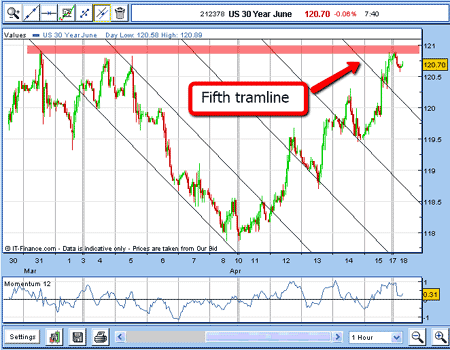How I profited from the US Treasury market
John C Burford explains how he profited by going long in the Treasuries market.
In my last post on the T-bond market, I left the trade open and promised to follow up until I closed my trade, which I did late on Friday 15 April, with a very nice gain.
One of the amazing things about this trade is how closely the rally has adhered to my tramlines which I drew in advance of trading after the first pair was put in.
If you are relatively new to charting, I hope you are starting to realise that the financial markets are patterned. If they were totally random, you would definitely not expect to see such patterned behaviour around my tramlines.
MoneyWeek
Subscribe to MoneyWeek today and get your first six magazine issues absolutely FREE

Sign up to Money Morning
Don't miss the latest investment and personal finances news, market analysis, plus money-saving tips with our free twice-daily newsletter
Don't miss the latest investment and personal finances news, market analysis, plus money-saving tips with our free twice-daily newsletter
Prices would dart all over the place, likely in reaction to the various news stories, or 'fundamentals', as traders adjusted to the new information.
'Trading on the fundamentals' is a ridiculous notion
I hope I have convinced you that the markets are not random, but are patterned (and probabilistically predictable). I hope also to convince you how ridiculous the concept of trading on fundamentals is.
For example, here is a list of possible 'reasons' (which are routinely trotted out in the press) why the dollar, for example, should either strengthen or weaken:
If the Fed continues its 'accommodating' QE monetary policy, that would be good for the US economy and therefore the dollar or it could be bad for the US economy because the Fed's policy is inflationary and therefore bad for the dollar.
If gold and silver rally, that would be good for the dollar because the market is looking for a 'safe haven', and the dollar has always been one or it would be bad for the dollar because rising gold prices means investors are losing faith in paper money.
If Europe's sovereign debt crisis continues, that would be bad for the euro and good for the dollar or it would be bad for the dollar and good for the euro because Europe's crisis remains contained, while the US is facing an even bigger debt crisis.
It's possible to make up similar scenarios for every market, including the T-bonds (and I have!). This way of thinking would have me sitting on the fence, scared to death to make any move at all!
But to get back to the T-bond market, as I mentioned in my earlier post on the market, the majority of traders are extremely bearish, and so any sign of life in the bonds would produce a very large reaction to the upside as the bond shorts scramble to cover their positions.
Let's get back to that T-bond trade
We saw last time that my fourth tramline was achieved very rapidly.
Dare I believe that if I draw a fifth tramline that it also could be reached? Let's draw one in and see:

(Click on the chart for a larger version)
Yes, indeed, on Friday, my fifth tramline was hit and we even got an 'overshoot', just as we saw at the third and fourth tramlines!
The market was within pips of my long-standing target at 121 (marked by the purple line), and with the weekend approaching, and the market showing overbought momentum on the hourly chart, I decided to be prudent and I took profits here. That was a profit of 230 pips in four days.
I will keep on the lookout for more trades probably going long, as I feel many bond bears are shorting this rally.
A thought for the bond bears
This is an example of a short-term trade. Of course, I'm sure many readers are more long-term oriented, and would not have taken profits here.
They would be holding, as they would be observing the golden rule: 'Cut losses short, let profits run', and raising their trailing protect-profit stops in classic stair-step fashion.
Finally here's a thought for the bond bears: It is not inconceivable that bond yields (which move inversely with price) can continue to fall (against expectations).
Here's why investors' eyes are focused on retail prices, which are rising and so they believe that inflation is rising.
But at the same time, the amount of money and credit in the system is falling.
In fact, the US is still in a period of disinflation and when investors realise this, bond yields could well fall further. The bond market could once again, get back on page one.
NB: Don't miss my next trading insight. To receive all my spread betting blog posts by email, as soon as I've written them, just sign up here .
Get the latest financial news, insights and expert analysis from our award-winning MoneyWeek team, to help you understand what really matters when it comes to your finances.
John is is a British-born lapsed PhD physicist, who previously worked for Nasa on the Mars exploration team. He is a former commodity trading advisor with the US Commodities Futures Trading Commission, and worked in a boutique futures house in California in the 1980s.
He was a partner in one of the first futures newsletter advisory services, based in Washington DC, specialising in pork bellies and currencies. John is primarily a chart-reading trader, having cut his trading teeth in the days before PCs.
As well as his work in the financial world, he has launched, run and sold several 'real' businesses producing 'real' products.
-
 High earners face £15k income hit by 2029 following Autumn Budget
High earners face £15k income hit by 2029 following Autumn BudgetRachel Reeves’s Autumn Budget means high earners – or HENRYs – are now looking at an income hit running into the thousands. Can you avoid it?
-
 Millions underestimate how many paydays are left until retirement - why you should be counting your payslips
Millions underestimate how many paydays are left until retirement - why you should be counting your payslipsKeeping track of how long you will be earning a salary for can help work out how much you need to put into a workplace pension